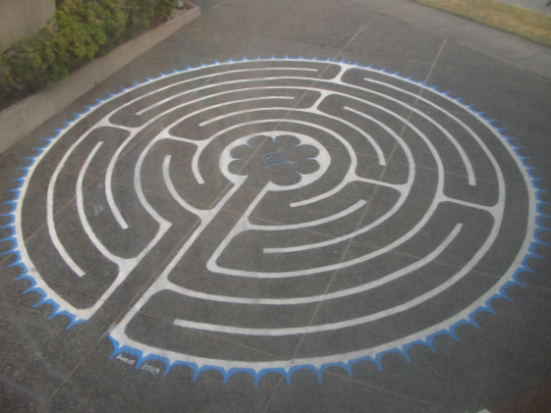 May 3rd is World Laybrinth Day. The following article first appeared in our March/April 2012 Family Caregiver Grapevine:
May 3rd is World Laybrinth Day. The following article first appeared in our March/April 2012 Family Caregiver Grapevine:
A labyrinth is a simple circle made up of curving inner paths that lead toward the centre, then away, then back again. Following the twists and turns helps many people match the physical act of walking with the mental and often spiritual practice of meditation. Labyrinth walking is catching on in health care settings, where the quiet mindful activity is being used to complement conventional medical treatments.
Labyrinths have been discovered in early cultures as far back as ancient Egypt, and are found in some of the oldest churches in Europe. The most well-known of these is in the Chartes Cathedral in France, which is believed to go back as far as the 13th century. Unlike mazes, which are designed as puzzles, the path of a labyrinth is meant to lead people on the journey. Some view following the path of the labyrinth as a type of pilgrimage or a mirror of life’s journey.
In recent years labyrinth walking has become increasingly popular, the circular patterns appearing in a variety of places, on church grounds, in public parks, in hospitals. Today they are used as a tool for quiet contemplation or mediation for those who have difficulty with conventional meditation or who cannot afford to attend classes.
Medical research, so far, indicates that walking a labyrinth produces health benefits similar to those of traditional meditation. That includes all the physical benefits of walking, such as stress reduction, lowered blood pressure and breathing rates, improved circulation and muscle tone.
In 2009, St. John the Evangelist Anglican Church, 220 West 8th, built its own labyrinth. It was the shared dream of church members Deborah Foster and Wendy Middleton, who dreamed of bringing one to their community.
Ms. Foster says the labyrinth, which is marked out in white paint and outlined with blue u-shaped lunations, is well used by the community. She points out that on any day she sees a variety of church and community members winding their way along the path—moms with toddlers, groups of teens, or elders.
The experience of walking the labyrinth is different for everyone. Foster states that people don’t often share much about their experiences. “They hold in their heart whatever takes place,” she says. Those who do share report a range of experiences, from mild relaxation to profound peacefulness and self-awareness.
Deborah Foster believes spirituality can be interpreted I many ways and that the labyrinth at St. John the Evangelist is open to all. “It’s a way of offering contemporary spirituality to the neighbourhood,” she says. “Labyrinth walking is universal. You don’t need a religion.”
In addition to the labyrinth at St. John the Evangelist, there are a number of public labyrinths in the Lower Mainland. Check out labyrinthlocator.com to find the surprisingly numerous labyrinths across in our area.
How to walk a labyrinth
There is no wrong way to walk a labyrinth, but generally, there are three stages:
Release: stand at the entrance of the labyrinth and take several slow deep breaths. Be aware of your feet on the ground. Deborah Foster suggests thinking of the thing that most concerns you and then actively let it go as you start into the labyrinth. Follow the path at your own speed and continue to let go of thoughts as they re-enter your mind.
Refresh: when you reach the centre, you may want to pause and reflect on your walk or continue to the outside of the labyrinth.
Return: continue to follow the path at your own pace. Feel free to walk the labyrinth as many times as you wish.
Posted by JP
